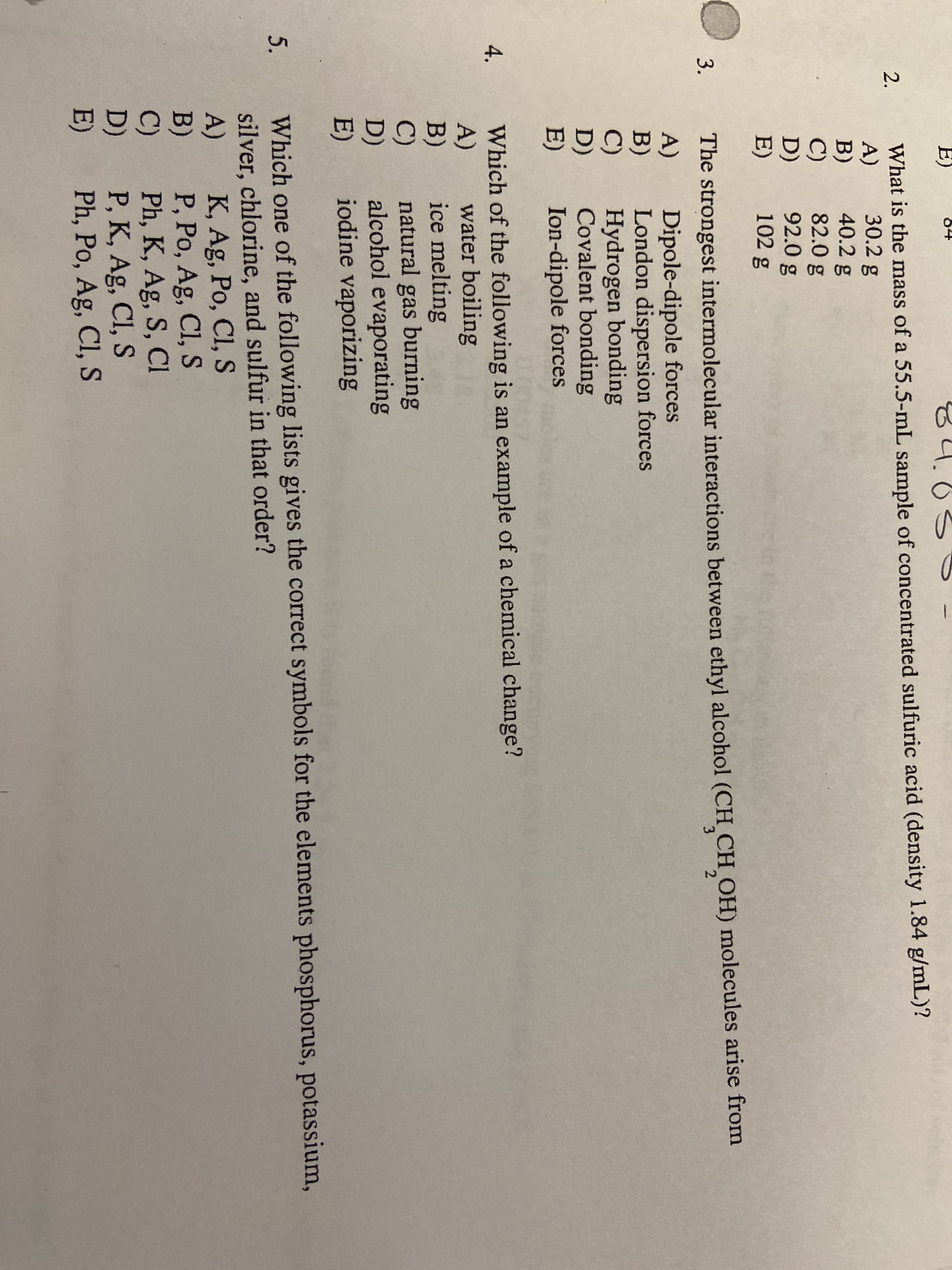E) 84.03 What is the mass of a 55.5-mL sample of concentrated sulfuric acid (density 1.84 g/mL)? A) B) C) D) E) 2. 30.2 g 40.2 g 82.0 g 92.0 g 102 g 3. The strongest intermolecular interactions between ethyl alcohol (CH CH OH) molecules arise from 3 2. A) B) C) D) E) Dipole-dipole forces London dispersion forces Hydrogen bonding Covalent bonding Ion-dipole forces Which of the following is an example of a chemical change? A) B) C) D) E) 4. water boiling ice melting natural gas burning alcohol evaporating iodine vaporizing Which one of the following lists gives the correct symbols for the elements phosphorus, potassium, silver, chlorine, and sulfur in that order? A) B) C) D) E) 5. K, Ag, Po, Cl, S P, Po, Ag, Cl, S Ph, K, Ag, S, CI P, K, Ag, Cl, S Ph, Po, Ag, Cl, S
E) 84.03 What is the mass of a 55.5-mL sample of concentrated sulfuric acid (density 1.84 g/mL)? A) B) C) D) E) 2. 30.2 g 40.2 g 82.0 g 92.0 g 102 g 3. The strongest intermolecular interactions between ethyl alcohol (CH CH OH) molecules arise from 3 2. A) B) C) D) E) Dipole-dipole forces London dispersion forces Hydrogen bonding Covalent bonding Ion-dipole forces Which of the following is an example of a chemical change? A) B) C) D) E) 4. water boiling ice melting natural gas burning alcohol evaporating iodine vaporizing Which one of the following lists gives the correct symbols for the elements phosphorus, potassium, silver, chlorine, and sulfur in that order? A) B) C) D) E) 5. K, Ag, Po, Cl, S P, Po, Ag, Cl, S Ph, K, Ag, S, CI P, K, Ag, Cl, S Ph, Po, Ag, Cl, S
Chemistry for Engineering Students
4th Edition
ISBN:9781337398909
Author:Lawrence S. Brown, Tom Holme
Publisher:Lawrence S. Brown, Tom Holme
Chapter8: Molecules And Materials
Section: Chapter Questions
Problem 8.92PAE
Related questions
Question
Questions 1,2, and 3

Transcribed Image Text:E)
84.03
What is the mass of a 55.5-mL sample of concentrated sulfuric acid (density 1.84 g/mL)?
A)
B)
C)
D)
E)
2.
30.2 g
40.2 g
82.0 g
92.0 g
102 g
3.
The strongest intermolecular interactions between ethyl alcohol (CH CH OH) molecules arise from
3
2.
A)
B)
C)
D)
E)
Dipole-dipole forces
London dispersion forces
Hydrogen bonding
Covalent bonding
Ion-dipole forces
Which of the following is an example of a chemical change?
A)
B)
C)
D)
E)
4.
water boiling
ice melting
natural gas burning
alcohol evaporating
iodine vaporizing
Which one of the following lists gives the correct symbols for the elements phosphorus, potassium,
silver, chlorine, and sulfur in that order?
A)
B)
C)
D)
E)
5.
K, Ag, Po, Cl, S
P, Po, Ag, Cl, S
Ph, K, Ag, S, CI
P, K, Ag, Cl, S
Ph, Po, Ag, Cl, S
Expert Solution
This question has been solved!
Explore an expertly crafted, step-by-step solution for a thorough understanding of key concepts.
This is a popular solution!
Trending now
This is a popular solution!
Step by step
Solved in 2 steps

Knowledge Booster
Learn more about
Need a deep-dive on the concept behind this application? Look no further. Learn more about this topic, chemistry and related others by exploring similar questions and additional content below.Recommended textbooks for you

Chemistry for Engineering Students
Chemistry
ISBN:
9781337398909
Author:
Lawrence S. Brown, Tom Holme
Publisher:
Cengage Learning


Chemistry: An Atoms First Approach
Chemistry
ISBN:
9781305079243
Author:
Steven S. Zumdahl, Susan A. Zumdahl
Publisher:
Cengage Learning

Chemistry for Engineering Students
Chemistry
ISBN:
9781337398909
Author:
Lawrence S. Brown, Tom Holme
Publisher:
Cengage Learning


Chemistry: An Atoms First Approach
Chemistry
ISBN:
9781305079243
Author:
Steven S. Zumdahl, Susan A. Zumdahl
Publisher:
Cengage Learning

Chemistry
Chemistry
ISBN:
9781305957404
Author:
Steven S. Zumdahl, Susan A. Zumdahl, Donald J. DeCoste
Publisher:
Cengage Learning

Chemistry & Chemical Reactivity
Chemistry
ISBN:
9781133949640
Author:
John C. Kotz, Paul M. Treichel, John Townsend, David Treichel
Publisher:
Cengage Learning

Chemistry & Chemical Reactivity
Chemistry
ISBN:
9781337399074
Author:
John C. Kotz, Paul M. Treichel, John Townsend, David Treichel
Publisher:
Cengage Learning